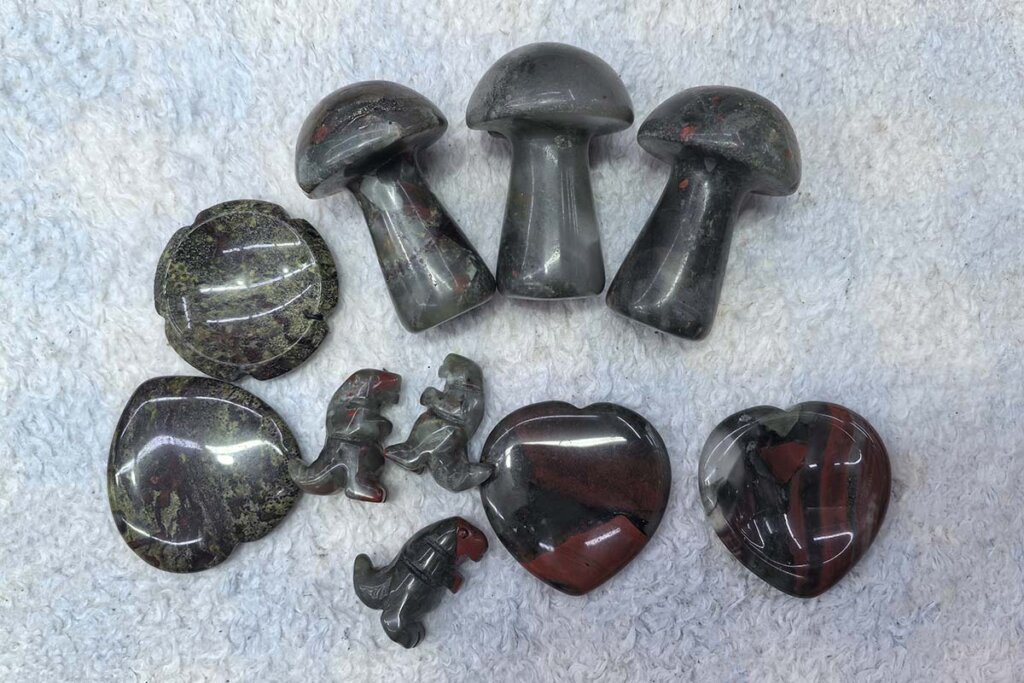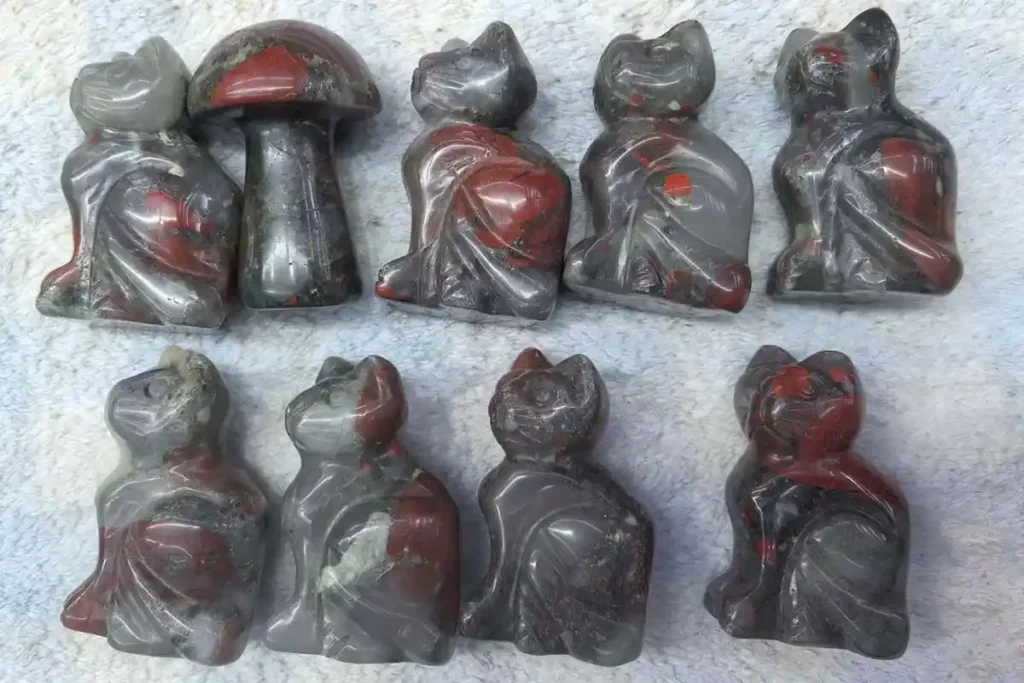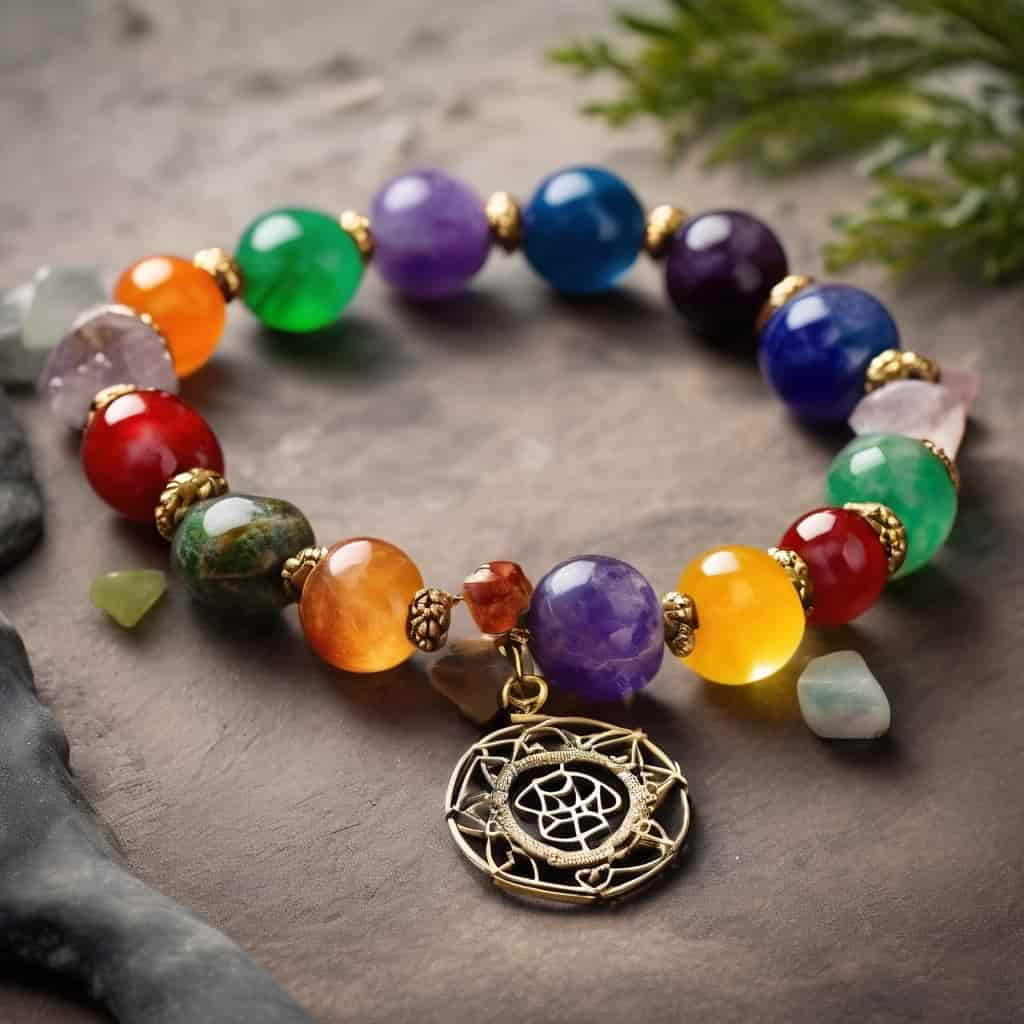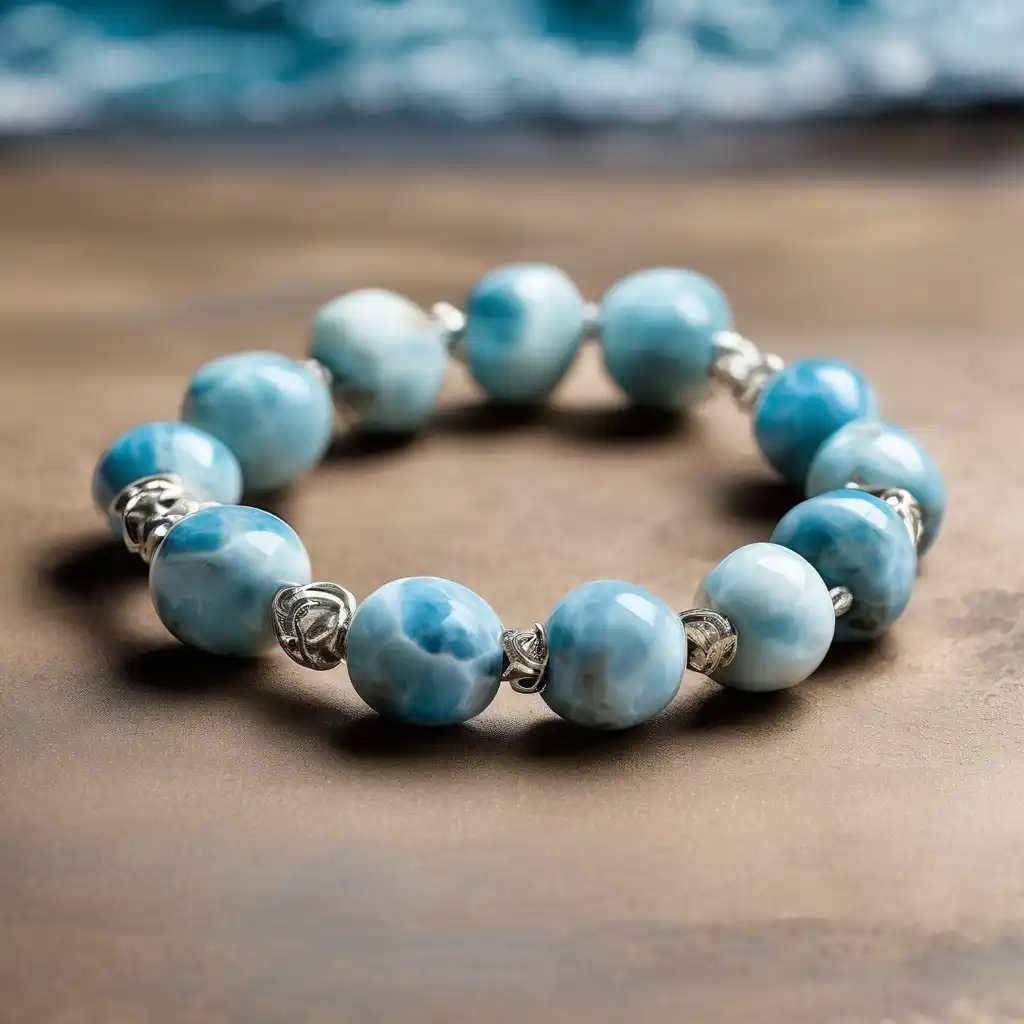African Bloodstone Meaning: Spiritual Benefits, Healing Power & Everyday Use
Introduction
If you prefer watching instead of reading, here’s a short video that explores African Bloodstone’s meaning and healing benefits.
African Bloodstone Meaning has fascinated spiritual seekers, crystal collectors, and healers. The energy of this unusual stone, which is frequently recognized by its deep green body with red flecks or swirls, blends spiritual renewal with resolute grounding. African bloodstones, as opposed to traditional Indian or European bloodstones have unique patterns that represent life, courage, and transformation.
In the realm of crystals, African Bloodstone Meaning is often linked to strength, life force energy, defence, and protection. It is regarded by many spiritual practitioners to be a stone of courage that helps in overcoming challenges and promotes harmony between the body, spirit, and heart. It has gained a place in jewellery, meditation techniques, and religious ceremonies all over the world due to its profound spiritual symbolism and potent energetic presence.
This perspective explores all aspects of African Bloodstone Meaning, including its spiritual significance and healing properties, as well as its scarcity, suitable wearers, and comparison to other types of bloodstone. Additionally, its significance in the traditions of chakra alignment, emotional balance, and physical healing will be covered. No matter your level of crystal collecting experience, learning about African Bloodstone Meaning can open your eyes to new ways of seeing its ethereal energy. Along with being a gemstone, it also represents courage, grounding, and inner transformation.
What is the Spiritual Meaning of the Bloodstone?
We must first look at bloodstone in general for the purpose of fully understanding African Bloodstone Meaning. Bloodstone, also known as heliotrope, is typically a dark green chalcedony with inclusions of red jasper. The stone’s name and long-standing connotation of vitality, blood purification, and life energy came from these “blood-like” spots.
In spiritual traditions, bloodstone symbolizes:
- Courage: Warriors in ancient times carried it for bravery in battle.
- Protection: It was believed to shield its wearer from harm.
- Vitality & Energy: Its connection to blood made it symbolic of life force.
- Grounding: It connects the body with Earth energy, providing stability.
African Bloodstone Meaning emphasizes renewal, transformation, and adaptability in order to expand on this basic symbolism. Its distinctive look, which frequently features swirling patterns of red, brown, green, and occasionally even golden tones, symbolizes the constantly shifting cycles of life. This variation differentiates it from other types of chalcedony and highlights its unique beauty for many collectors. According to some healers, its changing colours reflect the human spirit’s journey and serve as a reminder that change is something to welcome rather than to be afraid of.
When meditating with African bloodstone, many report feeling:
- A grounded calmness that steadies emotions.
- A surge of motivation to pursue goals.
- Cleansing of negative energy, especially around the heart chakra.
Therefore, the African Bloodstone Meaning is a vital stone for anyone seeking better alignment or navigating change because it links to both ancient vitality and contemporary personal growth. This gemstone has ageless wisdom, as demonstrated by its rising popularity in jewellery-making, holistic healing, and spiritual practice.
What’s the Difference Between Bloodstone and African Bloodstone?

A key part of understanding African Bloodstone is knowing how it differs from traditional Bloodstone. While both stones share the symbolism of life-force energy and vitality, their origins, appearance, and spiritual meanings are distinct.
📊 African Bloodstone vs Traditional Bloodstone
| Feature | Traditional Bloodstone | African Bloodstone |
|---|---|---|
| Origin | India, Australia, parts of Europe | Primarily South Africa and nearby regions |
| Appearance | Deep green chalcedony with red spots or streaks | Green with swirls of red, brown, yellow, and sometimes golden tones |
| Symbolism | Battle, courage, survival | Transformation, healing, adaptability, new beginnings |
| Energy Focus | Vitality, physical strength, purification | Renewal, personal growth, emotional balance |
| Best For | Those seeking protection, strength, and bravery | Spiritual seekers in transition, healers, and individuals experiencing rebirth |
👉 In summary:
Traditional Bloodstone is closely tied to courage, vitality, and survival, often linked with warriors and protection. African Bloodstone, on the other hand, carries more diverse patterns and a deeper spiritual meaning—encouraging transformation, emotional healing, and adaptability. It is a powerful ally for those going through life transitions, spiritual awakenings, or emotional renewal.
Who Should Wear African Bloodstone
Knowing who wears it for the greatest benefits is another aspect of understanding African Bloodstone Meaning. In the traditions of crystal healing, not everyone can connect with every stone. The energy profile of African bloodstone is most compatible with certain individuals.
1. People Looking for Courage and Strength
If you often feel stressed or exhausted, African Bloodstone can be a powerful support stone. Its energy strengthens your resolve and enables you to proceed with assurance. Many users claim that its grounding vibrations encourage tenacity and resilience, especially during uncertain times.
2. People Going Through Transition
Spiritual awakenings, job changes, and relationship changes can all be stressful. African Bloodstone Meaning resonates deeply with people going through a transition, assisting them in adapting and maturing gracefully. It helps you stay stable by reminding you that challenges are merely short-term steps toward stability and renewal.
Purchaser Note: When I went through a career transition, wearing an African Bloodstone bracelet helped me feel calmer and more focused instead of overwhelmed.
3. Spiritual practitioners and healers
Reiki practitioners, energy workers, and mediators can all benefit from African Bloodstone’s uplifting yet grounding qualities. It balances personal energy and strengthens protective shields. Some healers use it to cleanse aura fields, ensuring that any negative vibrations are removed, before starting more profound spiritual work.
4. Emotionally Overwhelmed People
African Bloodstone aids in easing emotional stress. Its association with the heart chakra makes it ideal for those struggling with grief, anger, or unresolved emotions. Wearing the stone every day could help you cultivate a softer emotional outlook and a more healing and forgiving mindset.
Author’s Note: I personally noticed that carrying it during stressful weeks reduced my tendency to overthink and helped me sleep better.
5. Do You Want to Be Protected?
Bloodstones have served as protective talismans since ancient times. African Bloodstone continues this tradition by offering energizing protection against negativity and psychic disturbances.
It’s a great stone for empathise who often absorb energy from their surroundings. Giving African Bloodstone jewellery, like bracelets, pendants, or rings, ensures constant energy contact and keeps the stone’s spiritual influence close to your aura throughout the day.
Some place it under their pillow for nighttime’s protection and to help with vivid dreams. Accordingly, the African Bloodstone Meaning is especially relevant for people who require courage, renewal, or emotional healing and opens the door to transformation, balance, and greater spiritual growth.
Is African Bloodstone Rare?
A common question when exploring African Bloodstone Meaning is its rarity. African bloodstone is much less common than some other healing stones, such as rose quartz or amethyst, but it is not the rarest crystal on earth.
Availability:
- African Bloodstone is primarily mined in South Africa and nearby regions.
- Compared to Indian bloodstone, it appears in smaller quantities on the market.
- Its distinctive swirling patterns make high-quality pieces more sought after.
Market Value:
- Because of its unique look, African Bloodstone often commands higher prices than standard bloodstone.
- Larger polished pieces and high-grade cabochons are considered collector’s items.
Spiritual Rarity:
Beyond its actual availability, African Bloodstone Meaning has a sense of rarity due to its transformational symbolism. In contrast to generic stones, it offers a blend of courage and adaptability that speaks to specific soul journeys. Because of its spiritual uniqueness, which adds to its mystique, it is more than just a decorative gemstone. Collectors claim that African Bloodstone “chooses” its owner, showing up when transformation is most needed.
This belief adds to the appeal of meditation, manifestation, and healing techniques. Fine pieces are much sought after and not always easily accessible, even though reliable crystal vendors sell it. Therefore, for crystal lovers, African Bloodstone Meaning is about connection—a special meeting between stone and spirit that increases both material and spiritual value.
What Does African Bloodstone Do Spiritually?

For centuries, the African Bloodstone Meaning has been tied to courage, vitality, and spiritual awakening. In a spiritual sense, this crystal is believed to act as an energetic shield, strengthening one’s innate life force while shielding the aura from negativity. African Bloodstone, according to many crystal healers, helps ground energy, align you with Earth’s frequency, and create pathways for higher consciousness.
Its deep green colour with red undertones stands for both blood and earth, and it also symbolizes strength, life, and re-growth. People who use it for meditation frequently report feeling more balanced, clear-headed, and spiritually rejuvenated. The African Bloodstone Meaning serves as a reminder that perseverance is essential for inner transformation and that growth frequently results from adversity.
Practical Uses and Benefits:
- Beyond meditation, people also use African Bloodstone in daily practices such as affirmations, chakra balancing, and energy cleansing rituals.
- Its grounding energy is especially valued in root chakra healing, where it provides a sense of stability, courage, and confidence to move forward.
- Many also believe that wearing this stone close to the body acts as a constant reminder of resilience, amplifying determination during difficult phases of life.
- Healers emphasize that the African Bloodstone Meaning is not only about strength but also about renewal — it guides individuals to release old patterns, embrace change, and step into personal empowerment.
- This makes it a powerful ally for anyone seeking spiritual growth, inner balance, or protection from negative influences.
By embracing African Bloodstone in these ways, its deep green and red flecks can act as a constant companion, promoting spiritual growth, resilience, and personal transformation.
Can African Bloodstone Get Wet?
The safe handling of crystals in water is a common question among healers and collectors. The African Bloodstone Meaning has a strong connection to cleansing, and it is safe to submerge it in water for short periods of time.
My Experience: I usually cleanse mine under running water and recharge it under moonlight. In my experience, it feels noticeably ‘lighter’ afterward.
However, crystal care experts advise avoiding prolonged soaking, especially in saltwater, which may damage its surface. Instead, you can cleanse African Bloodstone by:
- Rinsing under running water for a few seconds.
- Smudging with sage, Palo Santo, or incense.
- Leaving it under moonlight to recharge.
- Burying it in the earth overnight for grounding energy.
Also, some practitioners position the stone close to plants so that the plants can naturally absorb and release energy. Some enhance its vibration cleansing by combining it with sound healing techniques like chimes or singing bowls. In addition to safeguarding the crystal, these procedures maintain its capacity to channel spiritual rejuvenation and grounding power. This demonstrates how African Bloodstone Meaning is consistent with the cycles of natural purification and renewal, making it a dependable partner for energy resets, balance rituals, and spiritual development.
Who Should Not Use Bloodstone?
African Bloodstone may not be the best choice for everyone, despite its many spiritual advantages. Its strong grounding and energizing effects may be too much for some people, particularly those who are sensitive to crystal energy.

You may want to avoid working with African Bloodstone if:
- You prefer calming, gentle stones (like amethyst or rose quartz).
- You are experiencing hyperactive energy and need more stillness.
- You are drawn to softer vibrations rather than earthy, fiery ones.
The natural vibration of the stone may not align with everyone’s path, but this does not imply that it holds negative energy. For people who are looking for peace instead of empowerment, the African Bloodstone Meaning’s strong associations with transformation, strength, and vitality may be too strong. For instance, its fiery influence might feel over stimulating to someone experiencing stress or burnout, but it could also be very healing and motivating to someone else.
However, when used intentionally, the African Bloodstone Meaning offers courage, renewal, and balance to those who feel called. This makes it deeply transformative. The African Bloodstone Meaning transforms into a spiritual ally that adapts to your inner journey when it is approached with mindfulness and respect.
How to Tell if a Bloodstone is Real?
Bloodstone’s popularity led to many imitations. To honor the true African Bloodstone Meaning, it’s important to know how to identify a genuine piece.
Ways to verify authenticity include:
- Coloration: African Bloodstone has deep green tones with distinctive red, brown, or gold speckles.
- Hardness: On the Mohs scale, it ranks around 6.5–7, making it relatively scratch-resistant.
- Coolness: Like most natural crystals, it feels cool to the touch, warming slowly in your hand.
- Matrix patterns: Each piece has unique natural flecks; fakes often look too uniform.
The true African Bloodstone Meaning is demonstrated by the grounding weight and presence that come with holding a real stone. In addition to testing yourself physically, you can also rely on your instincts. In contrast to synthetic imitations, real crystals typically have a subtle energy that is both powerful and calming. In order to identify discrepancies, collectors frequently advise buying from reliable vendors, looking over authenticity certificates, and comparing the stone in natural light. In addition to safeguarding your investment, paying attention to these specifics guarantees that you are genuinely experiencing the African Bloodstone Meaning in its purest form.
Where to Put Bloodstone in Your Home?
The African Bloodstone Meaning and advantages can be enhanced by placement in your home. It is frequently placed where energy needs to be renewed and grounded.
Best spots include:
- Bedroom: Promotes restful sleep and spiritual dreams.
- Office/Workspace: Inspires focus, courage, and mental clarity.
- Living Room: Radiates protection and balanced energy.
- Meditation Area: Strengthens grounding during spiritual practices.
Personally, I keep a piece of African Bloodstone on my desk, and I’ve noticed it helps me stay focused during long writing sessions. I also placed one near the entrance of my home, and it gave me a comforting sense of protection, as if the space feels more grounded and welcoming.
African Bloodstone brings harmony, strength, and protection to your home. To prevent bad energy from entering the house, some people also place a piece close to the entrance. To strengthen rituals and spiritual practices, some prefer to place them on an altar or other hallowed area where intentions are made. The stone naturally blends in with its surroundings wherever it is placed, generating a constant flow of energy that encourages harmony. Through this deliberate placement, you can create a haven of peace and renewal in your home as well as within yourself by experiencing the African Bloodstone Meaning.
African Bloodstone Chakra Connection
The African Bloodstone Meaning is strongly tied to the Root Chakra (Muladhara) and the Heart Chakra (Anahata).
- Root Chakra: Enhances grounding, stability, and a sense of belonging.
- Heart Chakra: Encourages compassion, healing, and balanced emotional energy.
African Bloodstone can serve as a bridge between the spiritual and earthly worlds during energy work or meditation, reminding us that our strength originates from both our roots and our hearts. The stone promotes a balanced flow of energy by establishing a connection with these chakras, which makes you feel safe and allows your heart to be open to forgiveness and love. This dual connection, according to many practitioners, makes the African Bloodstone Meaning particularly potent for people looking to strike a balance between their emotional or spiritual development and their physical needs.
African Bloodstone and Zodiac Signs
Astrologically, African Bloodstone Meaning resonates most with the signs Aries, Pisces, and Libra.
- Aries: Strengthens courage and leadership.
- Pisces: Brings grounding to their dreamy energy.
- Libra: Balances emotional highs and lows.
As a result, it is a stone that can be used to meet the needs of many zodiac signs and strengthen spiritual resilience. Beyond these three, a lot of crystal healers observe that other signs during stressful or transformative times are supported by African Bloodstone’s stabilizing properties. Those looking for balance are naturally complemented by its energy, which helps to reveal latent strengths, ease emotional distress, and support personal development. Thus, the African Bloodstone Meaning goes beyond particular signs to provide universal assistance to anyone receptive to its healing vibrations.
African Bloodstone vs Dragon Bloodstone
Although both are powerful crystals, African Bloodstone and Dragon Bloodstone carry very different energies. One is grounding and nurturing, while the other is fiery and action-oriented.

📊 African Bloodstone vs Dragon Bloodstone
| Feature | African Bloodstone | Dragon Bloodstone |
|---|---|---|
| Appearance | Deep green with swirls of red, brown, yellow, or golden tones | Green base with bold red veins resembling “dragon’s blood” |
| Origin | South Africa and nearby regions | Mainly Western Australia and South Africa |
| Energy | Grounding, healing, protective | Fiery, energizing, empowering |
| Symbolism | Balance, renewal, emotional healing | Strength, courage, motivation |
| Best For | Meditation, emotional stability, spiritual growth | Boosting energy, drive, and overcoming obstacles |
| Energy Feel | Steady and earthy, like the strength of nature | Intense and fiery, like the force of a warrior |
👉 In summary:
African Bloodstone is best for grounding, balance, and renewal, making it ideal for those on a healing or spiritual journey. Dragon Bloodstone, in contrast, ignites courage, vitality, and motivation, serving as a powerful crystal for action, strength, and determination.
Healing Benefits of African Bloodstone (Physical, Emotional, Spiritual)
The African Bloodstone Meaning extends across multiple healing levels:
Physical Healing
- Supports healthy circulation and blood flow.
- Boosts stamina and vitality.
- Aids detoxification and immune strength.
Emotional Healing
- Releases fear, anger, and self-doubt.
- Encourages resilience during challenges.
- Balances mood swings with grounding energy.
Spiritual Healing
- Protects the aura from negativity.
- Enhances meditation and spiritual vision.
- Aligns Root and Heart chakras for harmony.
African Bloodstone is known as the “Stone of Courage and Renewal” due to its versatility. Beyond its reputation, many energy practitioners emphasize that consistent use deepens the African Bloodstone Meaning—supporting the spirit’s reconnection with greater wisdom, the body’s return to equilibrium, and the heart’s recuperation from emotional stress. Its healing power becomes a constant companion when incorporated into daily routines, promoting wholeness on all levels.
Origins: Where is African Bloodstone Found?
African Bloodstone is primarily mined in South Africa and parts of India. The African Bloodstone Meaning is rooted in its geological history, where its remarkable green-and-red pattern was created by sedimentary and volcanic processes.
Because of its African origin, many modern healers emphasize its grounding connection to Earth’s energy, which makes it an effective tool for both physical and spiritual strength. These distinct red flecks are frequently interpreted in metaphysical traditions as symbolic drops of life force, associating the stone with protection and vitality. Both collectors and healers appreciate its uniqueness and inherent beauty, pointing out that each piece has subtle variations that enhance individual energy work. Given that no two stones are exactly alike and that working with them offers a profoundly unique experience, this natural diversity serves to further emphasize the African Bloodstone Meaning.
FAQ Section
Q1: What is the main African Bloodstone Meaning?
A. It symbolizes courage, protection, vitality, and spiritual renewal.
Q2: Can African Bloodstone be used for meditation?
A. Yes, it is a powerful grounding stone that enhances focus during meditation.
Q3: Does African Bloodstone help with anxiety?
A. Its grounding energy calms the mind, reduces over thinking, and restores balance.
Q4: Is African Bloodstone expensive?
A. Not typically. Prices are moderate, though rare high-quality specimens may cost more.
Q5: Can I pair African Bloodstone with other crystals?
A. Yes, it pairs well with clear quartz (amplification) and amethyst (calmness).
Q6: How do I cleanse African Bloodstone?
A. Briefly rinse under water, smudge with sage, or leave under moonlight to recharge its energy and maintain the African Bloodstone Meaning.
Conclusion
The African Bloodstone Meaning symbolizes courage, stability, and spiritual renewal. African Bloodstone has influenced and empowered people throughout history, from its use as a talisman of strength to its current application in crystal healing. Wearing it as jewellery, putting it around the house, or using it for meditation, it reminds us that balance is the foundation of resilience and that gaining higher wisdom while remaining grounded is the path to growth. A living link to Earth’s power, the African Bloodstone Meaning leads us toward vitality, balance, and spiritual harmony. It is more than just a symbolic meaning.
African Bloodstone is useful in everyday life in addition to its symbolic meaning. Many spiritual seekers and healers think it eases emotional stress and gives courage in times of uncertainty, strengthening the body and mind. Its reviving vibration strengthens resolve to overcome obstacles, while its grounding energy keeps one steady. When incorporated into spiritual practice, it promotes increased intuition and clarity, directing change. The African Bloodstone Meaning reminds us that strength, rebirth, and a connection to the energy of the Earth are always possible by bridging the gap between traditional knowledge and modern healing.
For me, African Bloodstone has become more than just a crystal—it’s like a steady reminder to stay strong and embrace change. Whenever I feel uncertain, holding it brings me back to balance.




